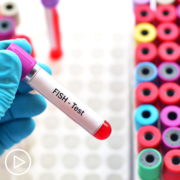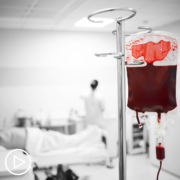Managing Life With an MPN | What You Need to Know
Related Programs:

|

|

|
Transcript:
Katherine Banwell:
Hello and welcome. I’m Katherine Banwell, your host for today’s program. Today’s webinar is a continuation of our Thrive series. And we’re going to discuss how to manage life with an MPN. Before we get into the discussion, please remember that this program is not a substitute for seeking medical advice. Please refer to your healthcare team about what might be best for you.
Let’s meet our guest today. Joining me is Dr. Raajit Rampal. Dr. Rampal, welcome. Would you please introduce yourself.
Dr. Raajit Rampal:
Hi. Thank you so much for having me. I’m Raajit Rampal from Memorial Sloan Kettering Cancer Center where I focus on myeloproliferative neoplasms.
Katherine Banwell:
Thank you so much for being with us today.
Dr. Raajit Rampal:
My pleasure.
Katherine Banwell:
As we do with each of the webinars in our Thrive series, let’s start with this question. In your experience, what do you think it means to thrive with an MPN?
Dr. Raajit Rampal:
It’s a great question, right. I think taking a step back, when we think about our patients with MPNs, one of the questions I always have for patients are what are your goals. And inevitably and invariably, people want two things. They want to live longer and they want to live better. And so, I think that thinking about thriving with an MPN to me is about how do we minimize the impact of an MPN in someone’s life. And that means a couple of things. One that means how do we deal with symptoms or things that are causing medical problems.
But two, how do we deal with the anxiety of a diagnosis? In many cases in my experience, that can be just as detrimental to somebody’s well-being as the actual physical symptoms of the disease.
Katherine Banwell:
When it comes to choosing therapy for polycythemia vera essential thrombocythemia, or myelofibrosis, it’s important to work with your healthcare team to identify what is going to work best for you. So, to begin, would you define shared decision making and why is this critical to properly managing life with an MPN?
Dr. Raajit Rampal:
Yeah. Shared decision-making, to me, is really about the physician or whoever is on the healthcare team providing the patient all of the information needed to make a good decision. That means what are we trying to do? What is the medication or invention going to accomplish? What are the side effects because there are always side effects.
And what do we think that’s going to do or how is that going to impact the patient’s life? Where things get nuanced is that patients come to us because we have expertise. There are two extremes. One extreme is that the physician says this is the medication you should take. End of discussion. The other extreme though is also not helpful, which is to say to a patient here are five choices. Here are the side effects. You pick one. Our job is to lay out those side effects and the benefits but then, also help guide a decision.
Katherine Banwell:
What are treatment goals and how are they determined?
Dr. Raajit Rampal:
It depends on the disease to a large extent. Now, when we’re dealing with ET and PV, the primary goal of our interventions is to reduce the risk of a clotting event or bleeding event. And that usually involves controlling the blood counts in some cases, not in all patients with ET.
Sometimes aspirin is all we do. Myelofibrosis is a little bit more complicated because it depends on what the problem is. Not all myelofibrosis patients have the same challenges. Some have anemia that needs treatment. Some have a big spleen. Some have symptoms and some have nothing and they just need observation. So, it’s a bigger list with MF patients. But I think the first part of the discussion always is defining what the goal needs to be.
Katherine Banwell:
What factors are considered when choosing therapy for ET, PV, and MF?
Dr. Raajit Rampal:
I think a couple of things. One is what medication we think is going to benefit the patient best. That has to take into account the individual, their willingness to take certain medications, for example, pills versus interferon injection. Some people have an aversion to self-injection, which we have to take that into account. What are the other medical conditions that the patient is dealing with?
And the reality is, in some cases, it’s cost because these medications, depending on a patient’s insurance, can have quite a different spread in terms of cost. Unfortunately, that is something we have to take into account.
Katherine Banwell:
Let’s talk about what sort of tests should be done following an MPN diagnosis. Can you tell me about those?
Dr. Raajit Rampal:
Yeah. Fundamental to the MPN itself, the things that we really want to know is, in most cases, a bone marrow examination is needed because that will tell us really what the disease is that we’re dealing with. It will tell us about the genetics. I strongly believe we have to be comprehensive in our genetic assessments because that does prognosticate and sometimes gives us an opportunity in terms of treatment. Chromosomal analysis. These are the basic bread and butter hematology tests we want to do from the bone marrow to really understand what the patient’s disease is.
Beyond that, I think that particularly in patients with PV and ET, it’s important that we partner with their primary care physicians to make sure that they’ve had, for example, testing for diabetes, a recent lipid profile, any cardiovascular tests, particularly measurements of blood pressure because these things are all important in terms of an ET or PV patient’s risk of having a blood clot. So, there are, again, things that are within hematology realm but then, there are other general health things that become really important in somebody who is diagnosed with PV or ET.
Katherine Banwell:
How often should lab tests of blood work be done?
Dr. Raajit Rampal:
It really depends on the patient. For some patients with PV, for example, they need to have their blood checked every three weeks because they’re having frequent phlebotomies. Whereas some patients with ET could probably go forward to six months between blood tests.
So, it depends on the individual.
Katherine Banwell:
How can results of biomarker testing affect treatment choices for patients with MPNs?
Dr. Raajit Rampal:
question. The genetics are becoming increasingly important in our treatment decisions. So, let’s take a simple example, which is patients with ET. Calreticulin and JAK2 and MPL are the three most common mutations that we see. But they have very different invocation. So, somebody could have a calreticulin-mutated ET and based on them having that calreticulin mutation and no other factors like no history of clotting, that patient may never need to go on a medication aside from aspirin. And even early on, it’s debatable whether or not some of these patients really need aspirin at all.
Whereas somebody who had a JAK-2 mutant ET, our guidelines and data suggests that that person, once they reach a certain age, should probably be on medication. So, that’s kind of perhaps one of our more clearcut examples of a genetic biomarker telling us how to approach treatment.
And then, it gets more nuanced from that and more exciting and interesting in the sense that there are mutations, for example, that occur in myelofibrosis and in patients whose disease is progressing towards leukemia, such as IDH mutations. And these are things that are now targetable with FDA-approved drugs.
And there are now clinical trials combining JAK inhibitors and IDH inhibitors for patients who have more advanced disease who have these IDH mutations. So, you go from on one end, these genomic markers being of prognostic significance and now, on the other hand, we’re getting to a point where, in some cases, they might tell us how to best treat a patient.
Katherine Banwell:
Dr. Rampal, should all patients diagnosed with MPN’s undergo molecular testing?
Dr. Raajit Rampal:
I strongly believe that. I think that we’ve learned so much that these tests have prognostic value.
And in some cases, it may suggest a slightly different diagnosis. I definitely think that should be the case.
Katherine Banwell:
What should patients be asking once they have the results?
Dr. Raajit Rampal:
What does it mean? That’s the most basic and fundamental question. It’s one thing to get a list of mutations. But the real bread and butter question is what does this mean to the disease and my prognosis and my treatment? Those are the key questions.
Katherine Banwell:
So, what are the types of treatments available for MPNs? And let’s start with myelofibrosis or MF.
Dr. Raajit Rampal:
If we had had this discussion five years ago, it would be pretty simple, and it would take a minute or two. And that’s completely changing and that’s amazing, and it’s good for all of our patients.
Right now, for patients with MF, it depends on what the issue is. If the issue is symptoms or spleen, JAK inhibitors are our first line of therapy. Three approved JAK inhibitors are currently available, two on the first side ruxolitinib (Jakafi) and fedratinib (Inrebic). And pacritinib (Vonjo) can be used for patients with really low platelet counts.
There is a fourth JAK inhibitor that we expect to be, hopefully, approved in June of this year, momelotinib. So, the landscape is about to complete broaden in terms of just JAK inhibitors.
But beyond the JAK inhibitors themselves, there are a number of late stage clinical trials that are combining JAK inhibitors with agents that work through a different mechanism that don’t work through inhibition of the JAK pathway. So far, these drugs have all shown promise in early phase trials. Now, the definitive Phase III trials are being done. We have to wait and see what the data tells us. But if these are positive trials, this could completely alter the landscape of MPN.
Katherine Banwell:
There’s also transplants available, right?
Dr. Raajit Rampal:
Correct. Transplants for more advanced patients, which comes with some major risks. And so, that has to be thought of very carefully in terms of the risks and benefit. But it is a potentially curative strategy.
Katherine Banwell:
Let’s turn to polycythemia vera or PV. What types of treatments are available?
Dr. Raajit Rampal:
It’s really quite a range. So, there are things like phlebotomy and aspirin, which has been the mainstay of therapy for many years. There are drugs like hydroxyurea (Hydrea), interferons, JAK inhibitors. So, ruxolitinib is approved in certain settings for treating polycythemia vera. So, the landscape is broad. There are a lot of questions going on right now with polycythemia vera with regards to how it should best be treated. Is the mainstay of phlebotomy and aspirin really what we should be doing or should we be giving patients treatment earlier on.
And there is some data to suggest that. There is this drug called ropeginterferon (Besremi) that’s FDA-approved for polycythemia, which was compared in the study to phlebotomy and aspirin.
And at least the data suggests that there may be better control of the disease and less progression possibly, and it’s a small number of patients, by treating patients earlier. Whereas we would have just given phlebotomy and aspirin. So, it’s something to consider. There are drugs in clinical trials as well that look promising one of which is called rusfertide, which actually works by changing the way iron is used by the body.
Iron is a key component to hemoglobin and it is, of course, a key component to polycythemia in the sense that we phlebotomize patients to make them iron deficient and that’s how we control the disease. But this is a pharmacological way to do that. So, that drug is now in Phase III trials. So, that may also alter the landscape of treatment of PV in the near future.
Katherine Banwell:
Finally, how is essential thrombocythemia treated?
Dr. Raajit Rampal:
So, in some cases, with absolutely nothing as we had talked about a moment ago. There is some thought that in really, really low-risk patients. Maybe you don’t need to do anything except observe them. Whereas most patients are on an aspirin. And beyond that, we have drugs like interferon, pegylated interferon, and hydroxyurea and anagrelide, all of which can be utilized. It’s not entirely clear if there is one distinct first line treatment that is the best but these drugs are all active. JAK inhibitors have been studied in this setting. And to date, the data hasn’t led to their approval but, certainly, people have studied it.
Katherine Banwell:
Dr. Rampal, how can you tell if a treatment is effective? Are there signs that you look for?
Dr. Raajit Rampal:
Well, I think it’s a couple of things.
One, are we meeting the treatment goals in terms of are we controlling blood counts with ET or PV? That’s one of the first principles in management. And with regards to MF, the same thing. Are patients’ symptoms being controlled? Is the spleen being adequately controlled? And then, there’s the symptom burden because just because the blood counts are being controlled, patients may still have symptoms, in which case, they are not being adequately treated. And then, we have to do our best to try to find a treatment strategy that does control their blood counts but also does control their symptoms.
So, there is the blood count perspective but there is the symptom perspective as well.
Katherine Banwell:
How do you know when it’s time to change treatments?
Dr. Raajit Rampal:
Well, I think really two things. One is if we aren’t meeting our goals like we just talked about. But the other aspect of that is if we are incurring toxicities that are just not tolerable to the patient and that’s a reason to change therapy always.
Katherine Banwell:
Many patients, of course, worry about disease progression. Are there key predictors or tests for progression that patients should know about?
Dr. Raajit Rampal:
This is a key area of investigation currently. I think one of the things that patients say to us so often when we meet them is what’s going to happen to me. And right now, we don’t have great prediction tools. We can say on a population level well, there is X percent of chance of progression at 15 years. That’s useful if you’re talking about a population. That’s not really useful if you’re talking to an individual. Because if I say to somebody there’s a 20 percent chance of your disease progressing to leukemia, it doesn’t really make a difference. That’s a meaningless statement because if you’re in the 20 percent who progress, it’s not a relevant statistic anymore.
It’s sort of a binary thing. We’ve got to do better at developing this. This is something that the MPN Research Foundation is really heavily invested in in trying to identify predictive biomarkers.
If we can do that, then perhaps what we can do is say to a patient this is really what we think your actual risk is. And then, the next step is asking the question if we intervene early, can we prevent that progression from occurring. So, that’s where I think we need to go. We aren’t there yet.
Katherine Banwell:
What signs or symptoms do you look for that may indicate that the disease is progressing?
Dr. Raajit Rampal:
The blood counts are often the canary in the coal mine regardless of the disease. They can tell us if ET or PV is progressing into MF or whether MF is progressing to more of a leukemic phase. Changes in symptoms sometimes can be a harbinger of disease progression. So, Patient 2, for example, is doing really well and now, he’s having drenching sweats and losing weight. So, those types of symptoms are a sign that physical findings is the size of the spleen if it’s increasing.
All of those things together give us a hint about progression.
Katherine Banwell:
Well, is there any way to prevent progression?
Dr. Raajit Rampal:
That is the million dollar question. Again, that’s where we ultimately need to be. We want to be able to intervene to a point where patients don’t get that sick. It would be amazing if we’d come to the point where we can intervene early and nobody progresses to late stage MF. Nobody gets leukemia. And I think that’s a worthy goal. That’s not something that we should think is too lofty of a goal. That should be our ultimate goal here. And a number of groups are investigating this exact question. It’s complicated and it’s going to take time. But I think that’s a worthwhile investment.
Katherine Banwell:
Let’s talk about MPN symptoms and treatment side effects. Here’s a question we received from a viewer before the program. How common is peripheral neuropathy in primary myelofibrosis?
And what is the best treatment for it?
Dr. Raajit Rampal:
Well, by itself, it’s not a very common symptom of MF by itself. Can it be a symptom? Sure. But there are also a number of things that can cause peripheral neuropathy. So, I’m not sure there’s a best treatment.
But what needs to be done is a thorough investigation. There can be a number of causes. It could be nerve injury. It could be a deficiency in vitamins like B12. There are a lot of things that could cause it. So, that type of a symptom needs to be thought of in a broad way in terms of diagnosis.
Katherine Banwell:
Jeff sent in this question. How could I manage the itching? Are there new treatments or strategies to live with itching?
Dr. Raajit Rampal:
Very common thing. And it’s an interesting thing explaining to when we teach our trainees about this symptom, we have to impress on them the fact that itching is not the itching that everybody else experiences.
This is a very profoundly different symptom. It’s debilitating for so many people. I have patients who go to the Emergency Room for that. That’s how terrible it could be. There are a lot of things that could be tried. JAK inhibitors, in my experience, work very well for itching but not in everybody. We use sometimes antihistamines that can work well. Sometimes, antidepressants can work well, not because they’re treating depression but because of other properties that they have. And sometimes, UV light therapy can be useful tool here, too. A lot of patients swear by it.
Katherine Banwell:
Another common side effect is fatigue. Do you have any advice for managing this symptom?
Dr. Raajit Rampal:
Fatigue is the most common symptom across MPNs. And it is also one of the most difficult things to treat. Part of the issue is trying to figure out what does fatigue mean to the patient.
When someone says they’re tired, does that mean they’re sleeping all of the time? Does that mean they don’t have get up and go? The first step is always understanding what does fatigue mean to the patient? And then, the second is trying to dissect that. In some cases, it’s related to anemia, in some cases, it’s not related to anemia and it’s just the disease itself.
And in some cases, you have to think outside of the box about general medical issues like thyroid dysfunction that could be at play here. So, there isn’t one best fit.
But the first test is always to dig deep. When someone says they have fatigue to dig deeper and try to figure out what is that really.
Katherine Banwell:
What other common symptoms do you hear about from patients? And what can be done about those?
Dr. Raajit Rampal:
There are a lot of different things. It’s a spectrum. So, I think that itching and fatigue are very common. Feeling full early is, that’s a big thing, particularly in myelofibrosis patients.
Bone pain, that’s another big one, particularly in myelofibrosis. There is not one therapy that is best for all. I think the JAK inhibitors, certainly, benefit many of these symptoms. But they don’t benefit everybody and not to the extent that makes it tolerable for everybody. So, often times, we struggle with this and try a lot of different things. But, again, I think one of the things to always remember is we don’t always want to say that this must be because of the MPN. Sometimes, symptom is arising because of another medical condition that’s going on concurrently.
Katherine Banwell:
That’s good advice. Thank you. Let’s answer a few more audience questions we received. This one is from Calvin, “If your hematologist says you’re stable and responding well to Hydrea, should you still seek out a second opinion?”
Dr. Raajit Rampal:
It’s never wrong to seek out a second opinion. I strongly believe that, especially when you’re dealing with a disease that’s rare like this.
And even seeking out a second opinion, even if you’re under the care of an expert in the field is never a wrong thing. I think that no one person knows everything. And sometimes, people’s experience and perspective is different. So, I don’t think that’s a bad thing ever.
Katherine Banwell:
As a follow-up to Calvin’s question, is it sufficient to just look at what the blood tests reveal? Or does having bone marrow biopsy dictate what treatment you should follow?
Dr. Raajit Rampal:
I think the bone marrow is important, particularly at initial diagnosis or when there is a change. The blood counts are the canary in the coal mine. So, they tell us is there something else going on that we’re not thinking about. And that’s when the bone marrow becomes important. So, I definitely think bone marrow is important at certain points in the disease.
Katherine Banwell:
Sandra has this question, “Are there new treatments for polycythemia vera being researched beyond interferon?”
Dr. Raajit Rampal:
Yeah. So, we talked about rusfertide as an example of this. And there are, certainly, other drugs that have been evaluated in this space. So, there is a lot of work going on for this disease, which is really encouraging.
Katherine Banwell:
Carolyn sent in this question, “Is there a possibility of bone marrow fibrosis reversal in myelofibrosis without a stem cell transplant?”
Dr. Raajit Rampal:
The answer is yes. So, even with JAK inhibitors, we see that about a third of patients will have a reduction in bone marrow fibrosis. And this is a key question being investigated with some of the newer therapies that are being introduced into the treatment of myelofibrosis. And, certainly, we’ve seen data to date that suggests that the fibrosis can be reduced if not potentially eliminated in some cases.
Katherine Banwell:
Dr. Rampal, should all patients diagnosed with MPNs undergo molecular testing?
Dr. Raajit Rampal:
I strongly believe that. I think that we’ve learned so much that these tests are prognostic value.
And in some cases, it may suggest a slightly different diagnosis. I definitely think that should be the case.
Katherine Banwell:
What should patients be asking once they have the results?
Dr. Raajit Rampal:
What does it mean? That’s the most basic and fundamental question. It’s one thing to get a list of mutations. But the real bread and butter question is what does this mean to the disease and my prognosis and my treatment? Those are the key questions.
Katherine Banwell:
Andrew wants to know does Jakafi cause other mutations to develop?
Dr. Raajit Rampal:
That’s a really good question. Right now, we don’t think the answer is necessarily yes. We have seen that in some patients where the disease has progressed on Jakafi, mutations have emerged.
But the problem is that genetic testing has limits of detection. In other words, the mutation appears, it may not have just appeared or been caused by the drug but that it may have been below our limits of detection and actually grew while the patient was on therapy, which does not mean that the drug caused the mutation but that it was allowed to emerge during treatment with the specific drug. So, that is an area of investigation.
Katherine Banwell:
Well, thank you, Dr. Rampal. And please continue to send in your questions to question@powerfulpatients.org and we’ll work to get them answered on future webinars.
You mentioned earlier clinical trials. And I’d like to dig a little bit deeper. Where do these fit into the treatment plan?
Dr. Raajit Rampal:
I think they should always be considered. None of the therapies that we have do we consider curative. And in many cases, standard therapy is fine given a patient’s clinical situation. In a case where standard therapy is not working or where we think that a patient’s prognosis is particularly challenging, or if they have mutations that may confer resistance to current therapies.
I think in those scenarios, a trial should always be considered.
Katherine Banwell:
So, if a patient is interested in possibly participating in a clinical trial, what kinds of questions should they be asking their healthcare team?
Dr. Raajit Rampal:
All of these trials are different. I think the first thing is to discuss what’s the risk, what’s the benefit of any given trial or drug. What stage and development is it? What’s the evidence to support it? And what can I expect from it?
Katherine Banwell:
What about cost?
Dr. Raajit Rampal:
So, trials, in general, have two components. One is what we call standard of care meaning that things we would do normally for in the course of a patient’s treatment would be billed to a patient’s insurance as if they weren’t on a trial.
Almost all trials, the study drug or any tests that are being done specifically with regards to the study drug are all covered by whoever is sponsoring the trial.
Katherine Banwell:
How do patients find out about where the clinical trials are taking place?
Dr. Raajit Rampal:
Usually, their physician should either, if they’re in a specialized center, they’ll have access there. But if they’re interested in trials and they’re being seen, for example, by a physician in the community who doesn’t necessarily specialize, asking for a referral to a major center where that MPN expertise is not an unreasonable approach to that. There is also clinicaltrials.gov where patients can go look for ongoing trials for their particular diagnosis.
Katherine Banwell:
So, if patients want to learn more about MPNs, what sort of resources would you recommend?
Dr. Raajit Rampal:
The thing I always say to patients is the internet is a very dangerous place for a variety of reasons. We have to, I think, do a good job of communicating to patients what are the resources. And the ones that I always point patients to are, for example, the MPN Advocacy International, the MPN Research Foundation, The Leukemia & Lymphoma Society, and the American Cancer Society. Those are sources of information that are vetted by physicians.
Some of that information is specifically for patients. Those, to me, are good sources for patients to read.
Katherine Banwell:
Dr. Rampal, as we close out our conversation, I wanted to get your thoughts on where we stand with progress and MPN care. Are there advances in research and treatment that make you hopeful?
Dr. Raajit Rampal:
Without a doubt. I think I’ve seen more progress in the last three years than I’ve seen in the last 10 years. And we have so many new drugs coming forward, new questions that we’re trying to answer, tough questions as you alluded to. The question about prognosis but also intervening early to prevent progression of disease. These are things that are difficult questions that we are trying to dig into now. So, I think we should be optimistic. We are seeing so many excellent developments. We’ll have to see how far they’re going to take us. I don’t think we know the answer to that. But this is an exciting time.
Katherine Banwell:
Dr. Rampal, thank you so much for joining us.
Dr. Raajit Rampal:
My pleasure.
Katherine Banwell:
And thank you to all of our partners. To learn more about MPNs and to access tools to help you become a proactive patient, visit powerfulpatients.org. I’m Katherine Banwell. Thanks for being with us today.






























